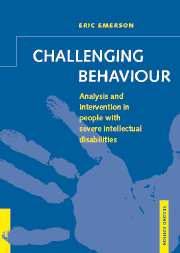2 - The social context of challenging behaviour
Published online by Cambridge University Press: 14 August 2009
Summary
In the first edition of this book, challenging behaviour was defined as culturally abnormal behaviour of such an intensity, frequency or duration that the physical safety of the person or others is likely to be placed in serious jeopardy, or behaviour which is likely to limit seriously use of, or result in the person being denied access to, ordinary community facilities (Emerson, 1995).
This amendment to the definition made by Emerson et al. (1988) made explicit the importance of social and cultural expectations and contextual factors in defining behaviour as challenging. Indeed, the phenomenon of challenging behaviour can only be fully understood when viewed as a social construction, a position which is highly consistent with the ‘contextualist’ world view of behaviour analysis (Morris & Midgley, 1990).
Whether a behaviour is defined as challenging in a particular context will be dependent on such factors as:
social rules regarding what constitutes appropriate behaviour in that setting;
the ability of the person to give a plausible account for their behaviour;
the beliefs held by other participants in the setting about the nature of intellectual disabilities and the causes of the person's ‘challenging’ behaviour; and
the capacity of the setting to manage any disruption caused by the person's behaviour.
Behaviour in social settings is, at least in part, governed by implicit and explicit rules and expectations regarding what constitutes appropriate conduct. In general, the more formal the setting, the more explicit the rules. Indeed, context is essential in giving meaning to any behaviour.
- Type
- Chapter
- Information
- Challenging BehaviourAnalysis and Intervention in People with Severe Intellectual Disabilities, pp. 7 - 16Publisher: Cambridge University PressPrint publication year: 2001



